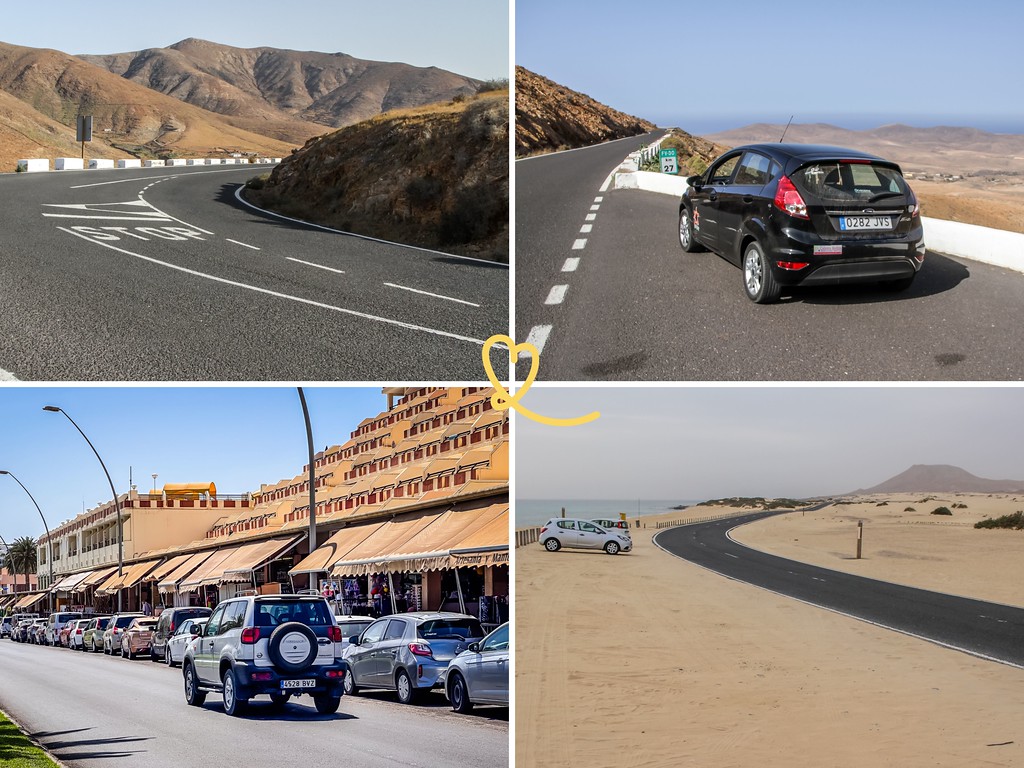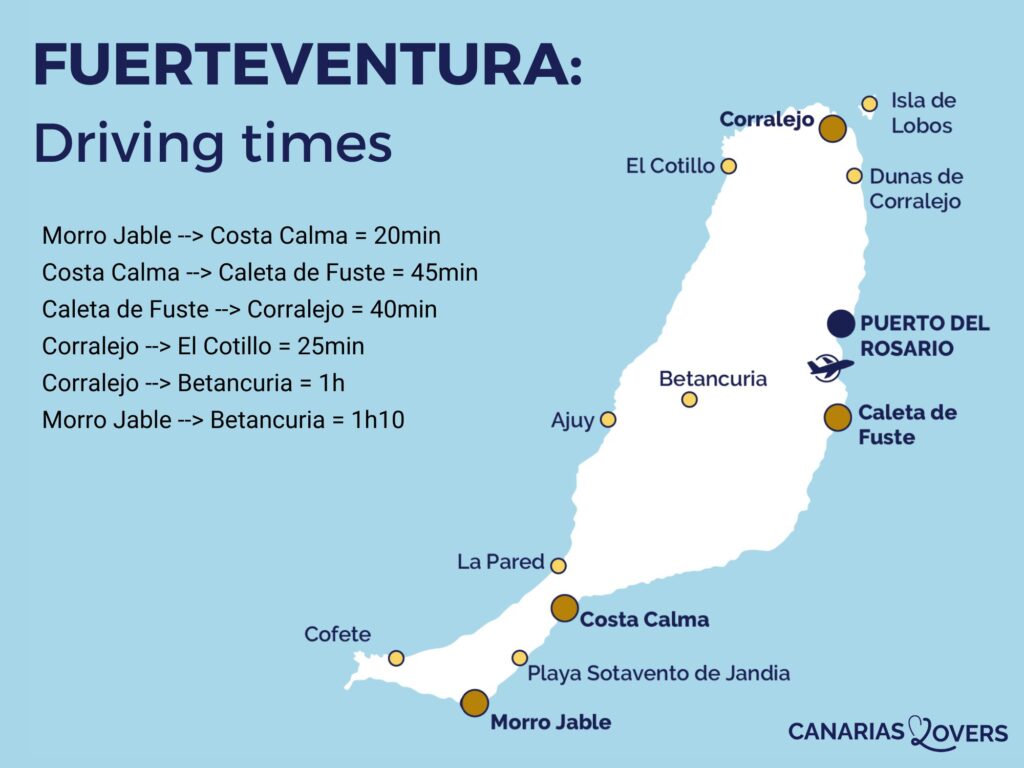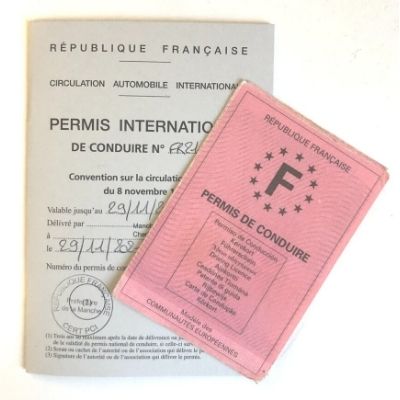Should you rent a car in Fuerteventura? Our answer is definitely yes.
Below you will find all our tips for driving in Fuerteventura, including :
- Is driving difficult? safe?
- Rules of the road and road signs,
- Road conditions and safety tips,
- Parking information,
- Advice for car rental,
- The most beautiful roads not to be missed,
- …
Don’t worry, it’s easy enough!

This opinion is completely independent, based on our experiences. We visited the region anonymously, making our own choices and paying our bills in full.
Driving in Fuerteventura: What you need to know
What you need to know before driving in Fuerteventura
If you don’t want to read the whole article, here are the essential points to know about driving in Fuerteventura:
- Minimum age 18
- Driving on the right-hand side of the road
- Roads are generally in very good condition
- It is forbidden to wear flip-flops when driving (as in many countries, but more strictly).
- Locals can be impatient, so don’t forget to check your mirrors for passing locals.
- In case of accident – emergency number: 112

Where we rent our cars
Our favorite platform, since we discovered it, is Discovercars.com.
As soon as we plan a trip, we immediately compare the cars available and the offers on them.
We love the ease of use, the filters for narrowing down the options with our criteria and their insurance, which works very well (and, yes, we’ve had to use it…).
But above all, we often found very good deals.
Click to see their current offers in Fuerteventura.
Or read our car rental tips.

Getting around Fuerteventura – do you need a car?
How is driving in Fuerteventura? Is it difficult? Is it safe?
Driving in Fuerteventura is generally easy and safe.
Most roads are wide and in good condition. And visibility is generally very good.
There are a few narrower roads, but these are the ones that lead to non-touristy places, so you won’t have any traffic on them.
There are also a few unpaved roads for a few hundred metres to reach certain places.
And then there are roads that require 4WD, like the road to Cofete, but that’s another question.

Do I need to rent a car in Fuerteventura?
- No, if you want to stay in your hotel and at the beach next door.
- Yes, if you want to enjoy the variety of landscapes that Fuerteventura has to offer.
- Yes, if you want to find secluded beaches or swim in natural pools.
- Yes, if you want to enjoy hidden gems off the beaten track
- …
Overall, we find that renting a car is the best way to explore the island and see all the best things to do.
This will allow you to see some of the most beautiful scenery Fuerteventura has to offer.
Getting around Fuerteventura without a car
It’s possible to get around Fuerteventura without a car, to see some of the sights, but it’s not flexible.
- Bus – There are buses between the main towns, but the frequency is not intense.
- Organized excursions – Excursions to the island’s best-known sites are available from the main resorts (Morro Jable, Costa Calma, Caleta de Fuste, Corralejo…) – see options
Map with driving times – Fuerteventura by car
Here’s a map of driving times you can expect in Fuerteventura.

A LITTLE MORE patience
All the photos, maps, information and addresses you need to make your stay in the Canaries a success will soon be available in a single ebook!
If you’d like to be notified when our guide to the Canaries is published, please subscribe:

Tips 1 to 6 – Rules for driving in Fuerteventura
Let’s start with the general rules and regulations you need to know:
1 – Licence requirements / Age – Do I need an International Driving Permit?
To drive in Fuerteventura / Spain, you need a valid driver’s license from your country.
If you hold a valid driver’s license, which includes :
- a license number,
- a photo,
- a validity date
- and is written in Latin letters,
- then you don’t need an international permit.
If not, you need it.
You must be 18 years of age (although many rental companies may have other age requirements).
You must also carry your vehicle registration documents and a valid form of identification, such as your passport, with you at all times.

2 – Side of the road
In Fuerteventura, driving is on the right-hand side of the road.
This means that traffic circles are taken counter-clockwise. And in Fuerteventura, they love traffic circles!
3 – General rules of conduct
- Seat belts are mandatory for all
- No cell phones while driving
- Headphones are illegal
- Children under 12 are not allowed to sit in the front of the car.
- Don’t wear flip-flops when driving
4 – Alcohol and driving
The legal alcohol limit here is 0.05%. Driving under the influence is considered a serious offence.
We always recommend not drinking at all if you’re driving.

5 – Mandatory equipment to have in your car
In Fuerteventura, the following equipment must be available in the car:
- 2 warning triangles
- Reflective vest or jacket
- Spare wheel and tools for changing it
- First-aid kit (recommended, not mandatory)
- Flashlight (recommended, not mandatory)
- Children weighing less than 18 kg must be placed in child seats.
- Children under 135 cm tall must be seated on a booster seat in the rear seats.
6 – Compulsory insurance
The only compulsory insurance in Fuerteventura is unlimited liability insurance – automatically included in the price of all car rentals.
If you come with your own car, don’t forget to bring proof of insurance.
Tips 7 to 15 – Safety: Road conditions and signs in Fuerteventura
7 – Driving on fast roads

Fuerteventura has no freeway, but it does have fast roads.
The maximum speed limit sign we saw was 120km/H, in one place and for a very short time. On the whole, it’s between 90 and 110km/h.
These roads are in excellent condition.
8 – Driving on secondary roads: mountains and countryside
Once off the freeways, the roads vary.
Almost all have at least one lane in each direction with a center line.
We didn’t find any particularly difficult routes.
Even in the mountains, the roads are still in excellent condition, with protective barriers and walls. No stress.

When you get off the beaten track, you can ride on smaller roads. These can have holes and bumps, but also much less traffic. So take your time, it’s easy if you don’t speed.
And if residents arrive, slow down and give way.

The only tarmac road where you have to be a bit careful, in our opinion, is the one that crosses the Corralejo dunes, especially if it’s windy.
It’s beautiful, but the sand on the pavement can be treacherous. Don’t drive too fast!
9 – Driving on unpaved roads
For some attractions/beaches, the last few hundred metres may be unpaved. But the roads are not very long and if you don’t drive very fast, it’s easy to get through.

On the other hand, it’s possible to take a more adventurous route along dirt or sand paths. But then you need a 4WD. Take a good look at the comments on the access roads before you embark.
10 – The road to Cofete: can you get there with a standard car?
One of the most frequently asked questions is whether it’s possible to get to Cofete without a 4WD.
The fact is, there’s no reason why you can’t take this road without a 4WD. We’ve seen small cars do it.
However, we don’t recommend it for 2 main reasons:
- The road is really full of bumps and holes, and quite long. Our backs were already aching in a 4WD.
- If you read the fine print on car rental contracts carefully, insurance does not cover driving on unpaved roads (even for 4WD rentals).
And taking on a guide allows you to learn more about the region, descend into sandy paths in some places and enjoy the scenery even more! See guided tours

11 – Driving in towns and villages
Once again, there are no major difficulties driving in the cities.
If a village has narrow streets, it’s often pedestrianized.
On the whole, the streets are wide and there’s not much traffic.
Even in the capital Puerto del Rosario, we found traffic very easy, with wide roads and plenty of parking spaces.

12 – Speed limits and signs
- Speed limits are indicated on circular signs with a red border and a number
- Speed limits are expressed in kilometers per hour
- National speed limits are: 50km/h in residential areas, up to 110km/h on main roads.
13 – Other road signs and tolls in Fuerteventura
Road signs are classic, in Latin letters, so there’s nothing specific you need to know.
There are lots of signs pointing the way.
Points of interest are indicated on brown signs.
There are no toll roads.

14 – Know the potential dangers on Fuerteventura’s roads
Apart from driving too fast, the main dangers on Fuerteventura’s roads are..:
- LANDSCAPES – The main danger is that you’ll be distracted by the stunning scenery.
- LOCALS – because you want to look at the scenery, locals going to work can be impatient. They can be a bit crazy when overtaking. So always look in your mirrors, especially when turning left (towards a home, for example) in the middle of a long straight road.
- CYCLISTS – At weekends, take extra care when overtaking.
- ANIMALS – we also saw signs saying to watch out for wild animals crossing the road…It’s probably during the night. What’s more, we love the drawing of the animal on it, because we have no doubt that we’re going to see a deer in Fuerteventura… very funny!

15 – What to do in the event of an accident
If people are injured or there is a conflict, the emergency number is 112 (with operators who speak European languages):
The best order of action is
- contact the emergency services
- contact the police
- contact your rental provider
WHERE TO STAY IN Fuerteventura
Option 1: Morro Jable
For its long sandy beaches, gastronomic and nightlife scene and activities. We recommend..:
- Hotel XQ Palacete, small hotel above the beach – see prices, photos and availability
- Hotel Buganvilla with its excellent spa – see prices, photos and availability
- 5-star Iberostar Palace Hotel – see prices, pictures and availability

Option 2: Costa Calma
For its beautiful beaches and water sports. We recommend..:
- Hotel INNSide Fuerteventura, our favorite on the island – see prices, photos and availability
- Hotel H10 Playa Esmeralada – for adults – see prices, pictures and availability
- Hotel H10 Tindaya for families – see prices, pictures and availability

Option 3: Corralejo
For the charm of the town, the number of activities, the choice of beaches and access to the island of Lobos. We recommend :
- Hotel Secret Bahia, for elegant luxury – see prices, photos and availability
- Hotel Boutique La Marquesina in the center of town – see prices, pictures and availability
- Island Hotel Fuerteventura, pur un aparthotel – view prices, pictures and availability

Tips 16 to 17 – Parking in Fuerteventura
16 – Parking in cities
Generally speaking, the parking spaces are very wide, which is pleasant.
We didn’t have too much trouble parking, even in high season, except in 3 places:
- The old town of Morro Jable
- On the Morro Jable lighthouse side, we had to climb up onto the ungroomed parking lots.
- In the center of Corralejo
If you’re staying in one of these places, don’t forget to check whether it includes a parking space or not.

17 – Attractions parking
Most attractions have large free parking lots.
The main attractions have paved parking lots, while off-the-beaten-track areas (such as the start of volcano hikes) may be unpaved. Drive slowly on these roads.
17 to 18 – Gas station
17 – Fuels
- Fuel is considered cheap compared to the rest of Europe
- The Spanish word for service station is “estación de servicio”.
- Gasoline is found on the green pump – called “gasolina” and if unleaded “gasolina sin plomo”.
- Diesel is found on the black pump called “gasoil”.
- At the moment, there aren’t many electric charging stations.

17 – Service station management
- There are stations just about everywhere, so don’t worry.
- Some have pump attendants to fill up, which we love. At others, you fill up the tank yourself.
- At night, you may have to pay in advance before you can refuel.
19 – Fuerteventura’s most beautiful roads
The island isn’t that big.
You can drive almost any road and admire the different facets of Fuerteventura.
We prefer to drive in Lanzarote as the scenery is more varied, but we do have some roads that we love in Fuerteventura:
- In the mountains around Betancuria, with all its watchtowers
- Down the valley to Pozo Negro and the lava flow
- Amid the sand dunes of Corralejo.

HAVE FUN WITH THESE activities
- North of Fuerteventura
Boat to Lobos Island
Buggy tour
Acua waterpark
Surfing lessons
- South of Fuertenventura
Dolphin watching boat tour
Buggy tour
4WD tour in Cofete
Surfing lessons

20 to 23 – Rent a car in Fuerteventura
Here is an overview of the main things you need to know.
Find out more in our article on car rental in Fuerteventura.
20 – Type of car to rent
- Most cars in Fuerteventura have manual transmissions. You’ll pay more for an automatic, and there are fewer options.
No specific size or power recommendations - You can find different car sizes
- So far, few electric cars
See the cars available on our preferred platform

21 – Where to rent
Car rental in Fuerteventura is available at the airport, the port and the main seaside resorts: Morro Jable, Costa Calma, Caleta de Fuste, Corralejo.
The largest car rental centers in Fuerteventura are:
- FUE Airport – see offers
- The port of Corralejo – see offers
22 – General tips for a carefree experience
- There’s nothing special about renting a car in Fuerteventura – no insurance and no special rules.
- As everywhere else, we recommend a thorough examination of the car before picking it up (and take photos).
- Book early for best prices and choice of cars
23 – Changing islands – ferry with rental car
Most companies do not allow you to change islands with your car. And you’ll be in big trouble if you go there and have a technical problem or an accident. Cicar gave us permission.
The best thing to do is to make a comparison:
- Cost of ferry for the whole group + car with a company that allows it
- Versus – Cost of ferry berth without car for whole group + rental in Fuerteventura
Video
Let’s end with a short video to give you an idea of what it’s like to drive in Fuerteventura: on the main roads, on the secondary roads and in the towns:
Video coming soon
PLAN YOUR TRIP TO Fuerteventura
- Best of
Most beautiful landscapes
Best things to do in Fuerteventura
Most beautiful beaches
Natural pools
Boat tours
Secret places, off the beaten track

- Practical advice
25 tips for a successful trip to Fuerteventura
How to get around
How to rent a car in Fuerteventura
Driving tips
Best excursions
Itineraries: 3 days – 4 days – 5 days – 1 week – 10 days

- Where to stay
Where to stay in Fuerteventura
Best hotels in Fuerteventura
5-star hotels
Best Boutique-Hotels
Best adults-only hotels
Best all-inclusive hotels in Fuerteventura
Best hotels for families
Best resorts (quiet or lively)




